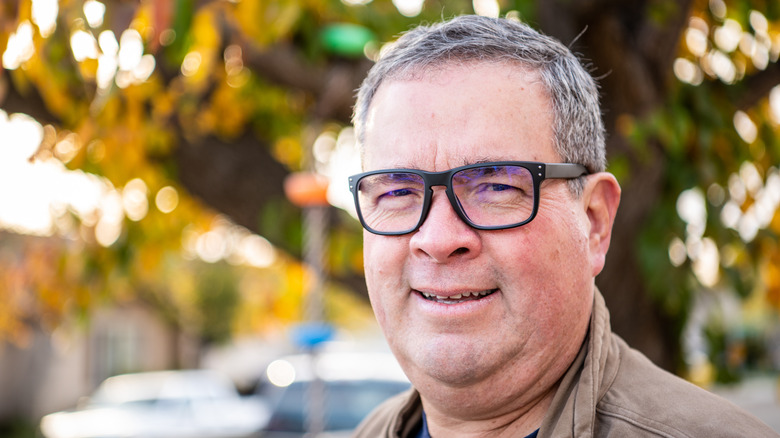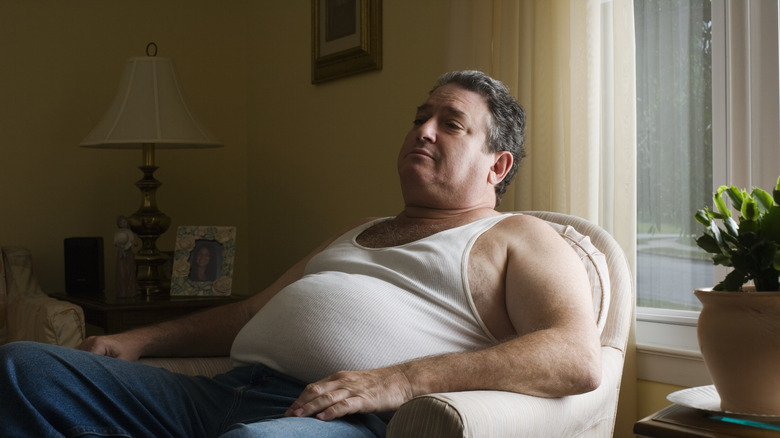Why Men Over 50 Have Increased Risk For Gynecomastia (Aka 'Moobs')
The Mayo Clinic writes that gynecomastia, colloquially referred to as "moobs" or "man boobs," is an increase in breast gland tissue in men or boys. This condition can affect one or both breasts and it may occur unevenly. They further note that there is another condition called "pseudogynecomastia." However, it occurs due to an increase in fat rather than the gland tissue itself.
Gynecomastia is not generally a serious problem, they state. However, it can be difficult to deal with emotionally. People with gynecomastia may feel embarrassed or ashamed of their appearance. They may also experience pain in their breasts.
There are a range of reasons why someone might develop gynecomastia, according to the NHS. The condition can be associated with being overweight. It might also develop in people who are taking certain medications. Additionally, some medical conditions such as hyperthyroidism, kidney disease, or cirrhosis can cause breast growth. Anabolic steroid use can cause gynecomastia, too. In newborn babies, the influence of the mother's pregnancy hormones can trigger it as well. Boys going through puberty and men over the age of 50 can experience gynecomastia due to hormonal changes.
How hormone changes cause gynecomastia in older men
Speaking specifically about the hormonal changes that occur in men over the age of 50, Babak Dadvand, M.D. discusses how common this condition is. At least 1 in 2 men are affected and its prevalence peaks between the ages of 50 and 80.
EBS Plastic Surgery explains that men in this age group experience declining levels of the hormone testosterone, which is the main sex hormone in men. This creates an imbalance between testosterone and estrogen, the hormone that causes breast tissue to grow.
In men who are overweight, higher levels of another hormone, aromatase, can play a role as well. This hormone helps convert testosterone into estrogen so excess aromatase can also contribute to hormonal imbalance and subsequent gynecomastia.
EBS Plastic Surgery further notes that chronic kidney disease, chronic liver disease, hyperthyroidism, and certain types of tumors can lead to hormone-related breast enlargement.
How gynecomastia in men over 50 is treated
The first step in treating gynecomastia is to get a diagnosis. Your doctor will ask you questions and run tests to determine if you are taking any drugs or have any medical conditions that might be responsible for your breast enlargement. Depending on what is found, you may need to discontinue the offending medication or get treatment for any underlying condition. Drugs like the estrogen blockers tamoxifen and raloxifene or the aromatase inhibitor anastrozole may be helpful in treating gynecomastia for some. If you still have excess breast tissue after treatment, liposuction to remove excess fat and surgery to remove breast gland tissue are also options (per Mayo Clinic).
Finally, it's important to recognize that gynecomastia's effects are mainly aesthetic; you don't have to get any treatment for it if you don't choose to. Dr. Rady Rahban, a plastic surgeon in Beverly Hills, California, commented to U.S. News & World Report, suggesting that people ask themselves: "How much does it bother you? It is essentially a cosmetic concern?" If it doesn't bother you, don't do anything. If it's affecting your quality of life, you may opt to get it treated.



